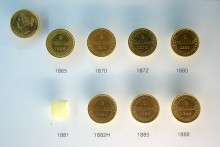The first Trade Dollars were not minted until 1873. If a coin says Trade Dollar and is dated with the year 1872 then it would appear that it must be a counterfeit coin.
However, if the coin is dated 1872 but it does not say Trade Dollar, then there is a possibility that it could instead be a genuine Liberty Seated Dollar. If this is the case then you should have it inspected by a dealer or certification agency because its value could range from anywhere between $300 and $1000 depending on its condition.
America's first bullion coin, the Trade Dollar, inherited this title almost by accident. Intended as a way of sending surplus silver overseas, within two years it had become a domestic bullion coin, much to the annoyance of ordinary citizens.
A bill providing in part for the issuance of the trade dollar was eventually put before Congress, where it was approved and later signed into law as the Coinage Act of 1873. The act made trade dollars legal tender up to the value of five dollars. A number of designs were considered for the Trade Dollar, and an obverse and reverse created by William Barber were selected.
The coins were first struck in 1873, and most of the production was sent to China. Eventually, bullion producers began converting large amounts of silver into trade dollars, causing the coins to make their way into American commercial channels.
However, if the coin is dated 1872 but it does not say Trade Dollar, then there is a possibility that it could instead be a genuine Liberty Seated Dollar. If this is the case then you should have it inspected by a dealer or certification agency because its value could range from anywhere between $300 and $1000 depending on its condition.
America's first bullion coin, the Trade Dollar, inherited this title almost by accident. Intended as a way of sending surplus silver overseas, within two years it had become a domestic bullion coin, much to the annoyance of ordinary citizens.
A bill providing in part for the issuance of the trade dollar was eventually put before Congress, where it was approved and later signed into law as the Coinage Act of 1873. The act made trade dollars legal tender up to the value of five dollars. A number of designs were considered for the Trade Dollar, and an obverse and reverse created by William Barber were selected.
The coins were first struck in 1873, and most of the production was sent to China. Eventually, bullion producers began converting large amounts of silver into trade dollars, causing the coins to make their way into American commercial channels.

